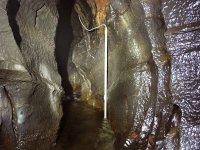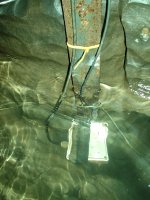"Measuring the velocity is the challenge." Er, no.
Forget velocity and floating bits of tat on the water surface. Besides which, velocity won't be a constant across the whole width of the passage or the whole depth of the water. I'm assuming you can measure the water depth somehow, either ad hoc readings or a logger.
Sorry, I should have pointed you to this page when I mentioned LMNO Engineering:
https://www.lmnoeng.com/manning.php
which says: "The Manning Equation is the most commonly used equation to analyze open channel flows. It is a semi-empirical equation for simulating water flows in channels and culverts where the water is open to the atmosphere, i.e. not flowing under pressure, and was first presented in 1889 by Robert Manning. The channel can be any shape - circular, rectangular, triangular, etc."
The Manning equation calculates V for you from just a bunch of dimensions of the water channel, water depth, K a constant fudge factor, etc. You then get Q from V*A as per usual.




